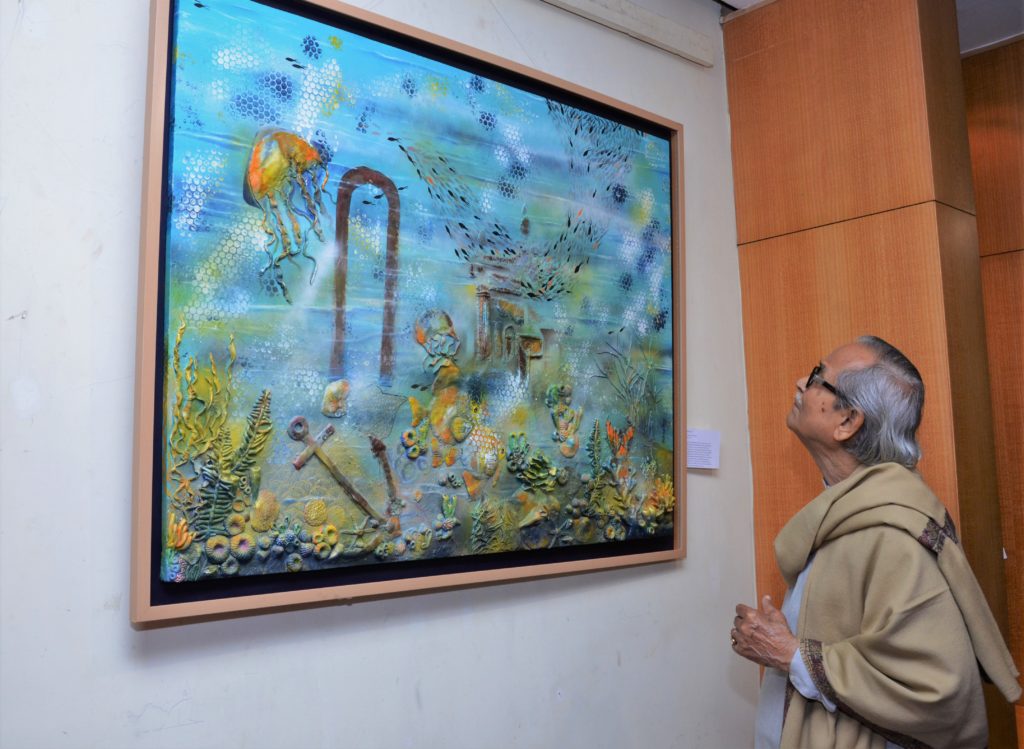“Creativity takes courage”
– Henri Matisse
(Reading Time: 26 min Approx)
It takes a lot of courage to go against your family to pursue your dreams. He left his house with 10 rupees in his pocket and enormous courage in his heart. Did he succeed? Did he achieve what he wanted to? Come; let’s hear from him- Niranjan Pradhan, the famous sculptor and one of the most humble Artists.
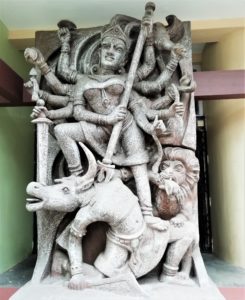
Q.1: Your works talk about reality of the flowing life and socio-temporal reality. What made you choose this theme?
“A sculptor cannot confine himself in a single theme. Whenever, whatever comes to my mind I depict it through my work. Theme can never be same when it comes to art. Even the sun rises differently every day. Art is all about portraying the way of life. The thinking behind every theme flows like a river. No one can plan it like that. So, each of my themes comes to me naturally.”
Q.2: The art of sculpture making is highly traditional and old as well. What kind of obstacles one has to face in this field?
“Well, it is not just about this field. For every creative field patience is a virtue. Long time practice is the only way out to acquire recognition. Hard work is very important whether you are an artist, writer or anything else. Also one should remember putting a lot of effort doesn’t always lead to success. You must know how to put your efforts and where. Still now, Rabindranath Tagore is our idol, inspiration when we look at the field of art and literature. Even Vidyasagar, the man who dedicated himself for the Bengali language cannot be compared to anyone.
Though, people disrespected him in every way possible he never turned his back to his countrymen, to his people. Without him the Bengali language would never have been discovered from Sanskrit. So, yes there will be obstacles, criticisms but that should not put you down from pursuing what you love. Because art is easy as well as complicated at the same time. There are no boundaries or protocols when it comes to art. Also artists and sculptors of our times are way different than nowadays. Their thinking is different. Because people hardly read nowadays. They invest more of their time in internet. Most of them don’t have any idea or respect to the field of art. That is affecting the idea of art in a bad manner.”
Q.3: You have pursued both painting and sculpture making. How would you define the connection between them?
“Sculpture making and painting, are two individual art forms. Painting is a two-dimensional medium. Whereas, sculpture making is three-dimensional. Sculpture is intricate not everyone can understand it. But people anyway praise it. Painting is colorful but sculpture has a one-color base. Because the art of sculpture making is not about its look, but about its formation. Each bend, curve, line invites the viewer towards it. As if, it can speak that- ‘Look this how I was made’. And another factor is the presence of light and shadow. In case of painting the front view is all but for sculpture the whole making process is different. Thus, the role of light and shadow is also different. The material value is the only dependent factor in sculpture making. Also sculptures have longevity more than any other art form. If you look at the ‘Harappa Civilization’, archeologists have discovered statues of dancers from there. There must be paintings too but where did they go? Due to natural calamities they got destroyed. Only sculptures can endure such time frame and still be intact to get recognized. Sculptures talk about their time, surroundings and to understand that one needs vision, the power to observe and identify.”
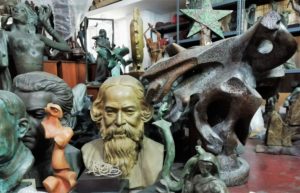 Q.4: The era of 1940’s affected the art of sculpture making in a rough manner because of World war, famine etc. You are considered to be one of the second generations of sculptor after Ramkinkar Baij. So, how tough was that phase of rebuilding for you all?
Q.4: The era of 1940’s affected the art of sculpture making in a rough manner because of World war, famine etc. You are considered to be one of the second generations of sculptor after Ramkinkar Baij. So, how tough was that phase of rebuilding for you all?
“How do you think Ramkinkar Baij got all the opportunities that we couldn’t? Because he had the blissful hand of Tagore over his head. Without him Ramkinkar Baij would never have achieved all that. Rabindranath gave him full freedom that every artist requires. He let Baij grow on his own way. Every person who received his proximity reached to the zenith. Tagore’s Santiniketan became a hub of culture and creation. People around the world rushed to him because he was that oracle of knowledge.
So, Baij acquired knowledge on art from all around the world. Which we can see in some of his Indo-western sculptures. It’s very rare to find someone who can curve your life and show you the path to your dreams. After the era of world war and famine it was really difficult to regain that because we didn’t get that amount of freedom and scope. A person can create something but it is his/her predecessor’s duty to retain that creation. Which was highly missing after Tagore, Baij passed away. The time changed rapidly. Even in context to our Govt. Art College, the entire ambience is different now. Somehow we have lost that originality of our Indian culture by trying to copy the western approach. That definitely made a huge problem.”
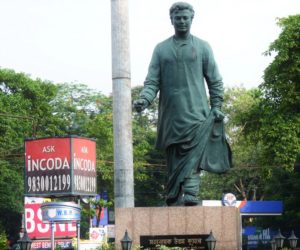
Q.5: Before going for public display of one’s work what should an artist expect or keep in his/her mind?
“Every artist believes his/her work is unique. No matter how deficits a child has his/her mother and father loves them with all their heart. So, to a sculptor all his creation is like a child. He/she can never reject any single one of them. Now, if you ask me about how to handle criticism; I will say criticism plays a very important role in life. Neutral criticism is important for the growth of art.
Without knowing feedback of viewers an artist can never grow. But this is true that in today’s world critics often express biased views and they try to insult artists by comparing them with one another. That is not healthy at all. so, the duty doesn’t only apply to the artists. It’s equally applicable for the viewers as well as critics to appreciate artists for their originality.”
Q.6: What is your opinion on today’s the art education, its deficiency with context to West Bengal as well as India?
He laughed and said- “Do you want me to get beaten up by answering this? It’s high time to say that the glorious past is fading away to some extent referring the art education system in West Bengal. Today we lack tutors who teach just for the sole purpose of teaching. Everybody is contending with one another and thus the collision is taking place in the field of learning art. Hence, no one is actually learning anything at all. Instead of learning art they are learning how to pull each other down to get recognized. When I told my parents, I want to pursue art as my career they told me not to.
They said art will not feed me. I thought to myself that we all are going to die someday. But what is the point if I die regretting that I couldn’t fulfill my dream though I knew it was the purpose of my life! So, I left home one day and came to Kolkata with just 10 rupees in my pocket. I have seen bad days. I have faced struggle but I am happy that I could keep the patience and will to follow my dreams. You die once but you live forever through your creations; how will you do that depends entirely on you. Being a student it’s your duty as well to acquire that knowledge from your mentor.”
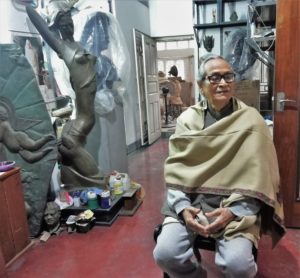
Q.7: How was your student life? Tell us something about that.
“I had the privilege to gain knowledge of art from respected artist Prof. Chintamoni Kar. He is my idol, my inspiration, my Guru. Whatever I am today wouldn’t have been possible without his guidance. I was a very headstrong student from the very first day. Whenever Sir told me not to do it that way, I always did the opposite. Sir scolded me for not listening to him but eventually I learned the does and don’ts in the Art of sculpture making. Making mistakes in your course of learning is very important otherwise you won’t be able to grow as an artist. Also my mentor Prof. Chintamoni Kar was always there to rectify my mistakes. He used to guide us thoroughly. A true Guru will never discourage his/her students from following their own ideas. He/she will let them explore on their own way because otherwise how will they learn?”
Let me tell you a little story – “It was my first day at wood-curving class. Sir gave us layouts and told us to execute them on small plank of woods as the exhibition was knocking on the door. We were instructed to use 2ft-3ft wood planks so that we can finish our projects in time. But I brought a 5ft wood plank because while explaining the work pattern I heard Sir mentioning that this kind of work would’ve been better in large plank of woods. That thing got imprinted on my mind and I decided to take it as a challenge. Sir saw and said – ‘This is the problem with you. You never listen to me’.
I said – ‘Sir, you’ll tell me how to do it. I will make sure I will finish this in time. If needed, I will work all day and all night. I will forget about everything else.’ ‘Just to remove the first layer and prepare the base for curving, it’ll take you 2-3 days! Anyways, you will not listen to me so do as you wish. If you don’t finish in given time; your work won’t be at the exhibition. That’s all I can say.’- saying this, Sir left for Delhi the next day for some seminar. I was determined, that I will make this happen. So, I went to Chadni Chawk market and bought electric wood shredder to finish the first layer in 1 day. I was happy that I finished it before time and was waiting for sir to come back.
Sir had a habit of visit our workplace at night and inspecting each and every artwork of the students. And then he used to call them one by one to give feedback in the morning. I was in cloud nine thinking sir will appreciate me for finishing the work before deadline. So I went to his office but he didn’t seem happy. I was wondering, what’s the matter? Why isn’t he praising my work?
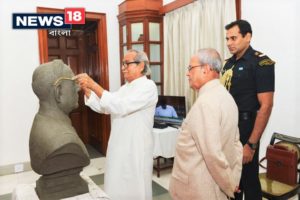
He looked at me with a quiet face and said- ‘A sculptor is a creator. He extracts woods from trees to create art. His job is to provide life into that piece of wood. How can you give life to your creation if you torture it like this? You finished the work early to prove me wrong but you failed to nurture your creation; you failed to love it and let it know that you understand its pain of being cut from a tree and you’re going to do justice to it by giving it life through your artistry.’
“That was the day, I realized why he is the Guru and I am the Shishya. No one ever explained me ‘Art’ more beautifully ever. All my life I kept those words in my mind for every sculpture I made afterwards.”
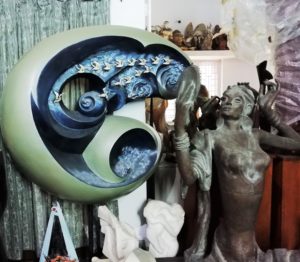
Q.8: You spent your childhood in Sundarban. We can see traces of that place in your works such as- ‘Princess of Waves, Under the Greenwood Tree, Cloud etc.’ Tell us more on that.
“It astonishes me that being from current young generation you have gone through my work and felt interested too. Being from the village, I was connected to nature since birth. My work ‘Princess of the Waves’ portrays the tumultuous waves of the ocean and a woman figure cherishing the sound of it. But I doubt how many people will get it that way.” I have seen an influence of sound in your themes. For example, the sculpture ‘Noise Pollution’ it solely takes about the present scenario how human race is facing the effects of sound pollution.
“Yes, you are right. Sound is one of my predominant themes from the very start. My artwork noise pollution that you can see in front of you is a human brain being hammered by sounds that don’t soothe one rather tortures one. The songs I hear nowadays are nothing but chaos. The background music is so high that one can hardly understand the words. I have tried to capture reality through this work of mine. You can see influence of sound also in another work of 1984 titled ‘Whirlwind’. Whirling movement of a different nature is observed here. The invisible wind in its fluttering movement gets a body. So, no matter where we go, be it city or village every human carries elements of nature inside him/her.”
Q.9: If you had to pick one or two of your works as your favourite, which will it be?
“How can a parent distinguish among their own children? All of my works are like my children. I loved doing each of my work on its own way. Because effort put in all of them is equal. If you ask me about the work ‘Cloud’, I loved curving the flying birds because it was one of the beautiful sights, I cherished during my days in my villages. I will keep making and loving all my work forever. Each one of them conveys a part of me and my life. I have gone old now and my eyes get blurry sometime while working. The toll of aging might reduce my working ability but my invested effort will always be of the same amount.”
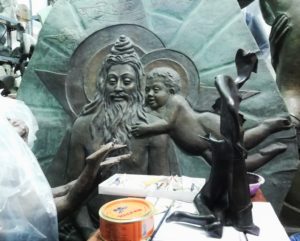
Q.10: ‘Beauty and the Beast’ is one of your fascinating works. The sculpture depicts a woman lying in an Eagle’s catch. Eagle itself is a beauty among the bird clan. Then what is the significance and symbolism of the sculpture?
“The word ‘Beast’ is often mistaken as something with a frightful appearance. In reality, the term beast signifies predators of our food chain. Thus, the Eagle feeding of the girl simply signifies the survival for existence in life. It talks about ‘Life and Death’ as a universal truth. We all are destined to embrace both of them when the occasion calls for it. From a socio-political approach, the society is beauty and the people who destroy the harmony of it are beasts.
Also, it points out the crime taking place on women these days. How they are being hunted under the influence of lust, power, and greed. Women are the beauty of our human world. They come in various forms- as mother, as sister, as a lover and as wife. Causing pain to them is the act of a beast. If you take it from the natural aspect, blooming of a flower, birth of a tree is beauty and arrival of the storm is beastly. But it also true that even destruction has its own type of beauty. So you cannot define beauty in one word. It is like the depth of an ocean-unfathomable.”
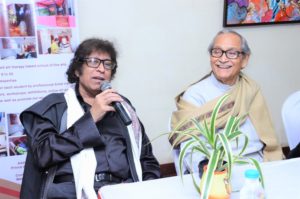
Q.10: What will be your suggestion for the budding artists?
“Follow your heart. I followed my heart and it was not easy but it produces inner peace in me thinking that I don’t regret of choosing my dreams over money making. Also, try to acquire knowledge from your Guru as much as you can. Learning is what makes us progress.”
Q.11: If you haven’t been an Artist; what would you have been?
“I would have always been an artist; because I couldn’t have given 100% of myself to anything else than ‘Art’. It’s my life, my identity…It’s ‘Me’.”

